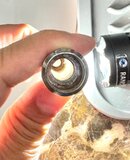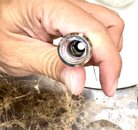I'll continue my own thread as I'm slowly getting there…
I'm planning to service my regs in about two weeks when I hopefully get my full mine course finished.
(my first dives after the service won't be in mines)
So far I have gathered all needed tools and service kits for servicing Apeks DST and MTX-R 1st stages and XTX40/50 and MTX-R second stages. For now I want to service my nitrox/trimix regs and oxygen clean is not necessary for 1st stages. Altough I would like to do everything so that it is oxygen clean, just for practice. My regs are in good condition and I mostly dive in fresh water.
For cleaning I would like to use chemicals that are and easy to dispose. Feels like most ready made ultrasonic cleaner solutions that are sold in Finland are some sort of toxic waste.
Cleaning process:
1. Clean my tools, I have used same o-ring picks with torch o-rings, maybe I'll get another set, but still make sure my tools are clean.
2. Disassemble regulators
3. Use powder free latex or nitril gloves for cleaning and assembly
4. Wash parts (including service kit parts) to get grease off:
- Use nylon brush
- Many use Simple Green, Joy, Dawn, … which are not available (or Really expensive) in Finland.
- Anyone have suggestion for similar product available in Finland/Europe?
5. Rinse with water to get all detergent off
6. Wash metal parts in ultrasonic cleaner:
- Use white vinegar with water 1:1
- 10% can be found on all stores here
- 1-3 minutes
7. Rinse with water to get rid of vinegar and everything that ultrasonic released
8. If parts are not clean, then repeat cleaning
9. If parts look clean then rinse with sterile water
- Cheap from pharmacy
10. Blow dry with (clean) air
11. Assemble and use Christo lube on all o-rings
Questions:
1. What to use instead of simple green that is available in Finland/Europe?
- Or what not to use? There are a lot of dish washing solutions for grease removal but which one to choose?
2. Apeks service kits has oxygen compatible parts, but do you use Viton o-rings for 1st stage if it's used with 100% oxygen? Or do you just clean oxygen compatible parts before use?
Quote from Harlows Oxygen hacker:
"While viton is less likely to combust, when it does, it produces fumes that are extremely toxic, even in trace amounts. For this reason, several SCUBA regulator manufacturers have specifically recommended against the use of viton!"
3. Has anyone read this
TDI Equipment Service Technician Manual - International Training Online Store and Is it worth buying?
Thank you for all the comments.






